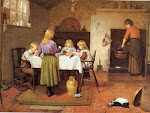So the Preface to the 2nd Edition has a lot of parts to it. So much to take in and think about. Right off the bat she begins with the story of her daughter, who could write but couldn't read. She told in wonderful detail how she learned to read - by learning Greek, of all things! And emails with Grandma. Haha! This entire section made me sigh in relief. All kids learn to read - in their own time - and in their own way. I know this to be true of half of my own kids (the other half are still up and coming), and it felt so good to get confirmation that other kids do this, too! Eventually it just clicks. We just have to be patient and enjoy the ride and follow their lead.
Rather than emphasizing grammar and structure, etc, Brave Writer emphasizes "a conscious appreciation of quality writing" (p. xiii). I love how she helps us do that. Read good books and non-fiction literature. Find answers to questions by leading them to new questions. Stick with the material over a period of time so they can really get to know it. Understand and think deeply about the techniques and language of the most successful writers.
Copy the masters. Watch the masters. Understand the masters. Just as an artist studies the masters to learn how to paint or sculpt better, a writer imitates the great authors until they break free and discover their own voice.
Ah, the element of surprise. Julie talked about how great writers surprise us in their work. Comparisons, referencing pop culture, new vocabulary words, insightful or novel positions taken in their work to open our minds and hearts, and an organizational surprise - leaving the topic sentence until the end. I highlighted all of these in my book and, as part of my assignment this week, will begin looking for that surprise while reading to the kids.
Listening to our kids and having meaningful conversations is a challenge in a large family household like ours. With 7 children competing for my time and attention every day - plus a husband ;) - maybe "challenge" is an understatement. But Julie describes these conversations as critical to gaining new words, which lead to better writing.
I was especially intrigued by her descriptions of freewriting. She goes into more detail on this in Chapter 4, but touches on it here in the preface. One caution she gives: if your student is finding freewriting to be challenging or a chore, he is not ready to begin revision. Wait until he is very comfortable writing and enjoys it. And go by their readiness, not a timetable you arbitrarily set.
To transition, she suggests freewriting once a week for 8 weeks. Each week they write for awhile, and then they have a choice. Ask, "Would you like to read it to me?" Yes? Wonderful! Don't look at it, just listen. And then compliment at least one thing you genuinely enjoyed. No, he'd rather not read it? That's fine! Either way, put it into a manila envelope and clasp it shut. DON'T PEEK AT IT, MOM! I know it's tempting, but don't!
At the end of those 8 weeks, the student will have 8 freewrites. Compliment her on having so many pieces of writing, and then ask which one she is most interested in. Explain that we'll revise it together - improve it, give it new vision, and polish it up so that we can share it with others (Dad, Grandma, friends, whoever).
How to revise: the Snip and Pin Revision.
I *loved* this revision method! After I read through it, highlighting and underlining all the important parts (and there were a lot), I boiled it down to 14 steps, as follows:
- Type it up - 3 spaces between each sentence (I took this to mean hit enter 3 times between each sentence)
- Print it out
- Cut out all the sentences
- Move those pieces around. Mix, toss, mix, choose, mix; arrange it all before rewriting
- Reread the whole thing. Any gaps? Missing info? Label words? Fix those now.
- Revision (Ch. 7 goes into details) - but only pick 3 or so critical points to revise (follow steps 1-5 here)
- Revise the opening and conclusion (again follow steps 1-5 for this)
- Staple all those strips onto new paper to keep them in order
- Rearrange, copy and paste on the computer to match the stapled strips
- Print it out
- Edit (Ch. 8 gives these details)
- Fix the edits on the computer
- Print it out
- Enjoy!
And finally, we don't have to revise *everything.* Not everything needs to be. Sometimes they're good enough. Sometimes she just likes it the way it is. And that's OK. They belong to her.
My assignment this week:
- I began the 8-week freewrites this past week. So I will do Week 2 this week.
- As I read with the kids, make a deliberate attempt to discover elements of surprise in the writing.


No comments:
Post a Comment